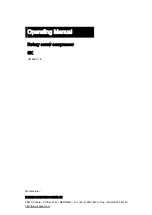
© 2017 Emerson Climate Technologies, Inc.
4
INTRODUCTION
This bulletin describes the operating characteristics,
design features, and application requirements for all
Copeland Scroll
™
compressors for refrigeration
applications using CO
2
(R-744) for a subcritical
operation. For additional information, please refer to the
online product information accessible from the Emerson
website at
Increasing
environmental
concerns
about
the
potential
direct
emissions
from
HFC-based
refrigeration systems into the atmosphere have led
system designers to revisit refrigerant R-744 (CO
2
). In
comparison with HFC refrigerants, the specific
properties of CO
2
require changes in the design of the
refrigeration system. The ZO range of Copeland
Scroll compressors has been designed to exploit the
characteristics of CO
2
refrigeration systems. The
efficiency, reliability and liquid handling advantages
of Copeland Scroll technology make it ideal for these
applications.
The
comparably
high-pressure
level
and
thermodynamic properties of the refrigerant CO
2
have
driven system designers towards low temperature
cascade systems, where CO
2
is used as a direct
expanding refrigerant in the low temperature stage. In
these subcritical cascade applications, the CO
2
compressor in the low temperature stage is still exposed
to pressure levels higher than in standard HFC-based
systems. However, they are limited to pressure levels
like those already known from air-conditioning
applications with refrigerant R-410A. An HFC refrigerant
is typically used in the medium temperature stage of the
cascade system.
The challenges for CO
2
compressors compared to HFC
compressors lie in the high-pressure levels, the higher
mass flow for a given displacement, and designing for
proper lubrication. In terms of mechanical strength, ZO
scroll compressors benefit from many years of
experience with R-410A air-conditioning compressors,
which operate at similar pressure levels as CO
2
compressors.
CO
2
FOR LOW TEMPERATURE APPLICATIONS
SUB-CRITICAL DX SYSTEM
at the end of this bulletin shows a cascade
system diagram with HFC refrigerant for the high side
and sub-critical CO
2
for the low stage refrigerant.
Nomenclature
The model designation contains the following technical
information about the compressor:
ZO D 34 K 3 E - TFD - 269
Z
=
Compressor family: Scroll
O
=
Refrigerant: R744, subcritical operation
D
=
Digital Model; Blank= Standard Model
34K
= Nominal Capacity (KBTU/HR)
3
=
Model variation
E
=
Oil type: POE oil
TFD
= Electrical Description:
T
=
Three Phases
F
= Internal Inherent Motor Protection
5,7,D & E
= Nominal Voltage Range
269
= Bill of material
Please refer to Online Product Information at
Refer to
for a detailed list of ZO Family Models.
Approved Oils & Refrigerants
Recommended quality for carbon dioxide purity
grade is 4.0 [(≥ 99.99 %) H2O≤10ppm, O2≤10ppm,
N2≤50ppm] or higher.
Emkarate
RL 68 HB
is approved for new and service
applications.
Oil recharge values can be taken from
Copeland Scroll compressors brochures or Copeland
™
Products Selection Software.
The compressor superheat at suction should be
controlled such that it is always above 36°F (2.2 °C)
to avoid oil dilution in the compressor but low return
gas temperature enough to keep the compressor
discharge temperature below 250°F (121.1°C),
especially at high compressor ratios (high
condensing and low evaporating temperatures).
Note:
A separate heat-exchanger may be required
to maintain the recommended superheat.
Mounting Parts
Specially designed rubber grommets are available for
mounting (Kit 527-0157-00). These grommets are
formulated from a high durometer material specifically
designed for refrigeration applications. The high
durometer limits the compressors motion thereby
minimizing potential problems of excessive tubing
stress. Sufficient isolation is provided to prevent
vibration from being transmitted to the mounting
CAUTION
































